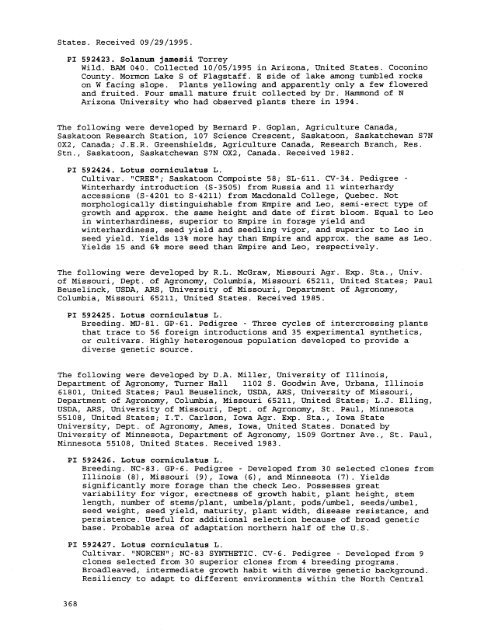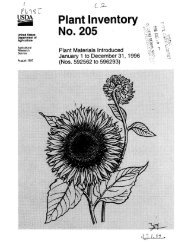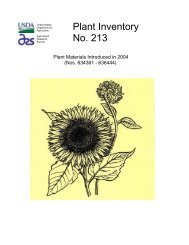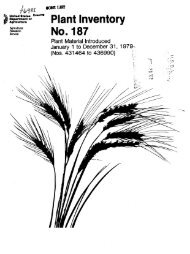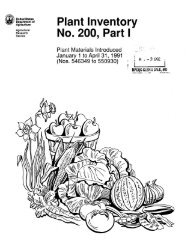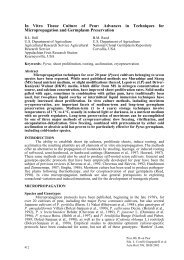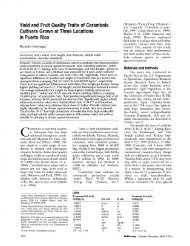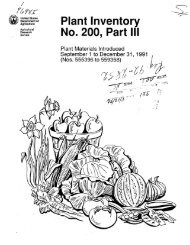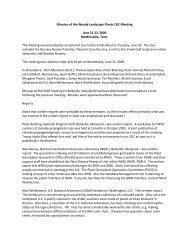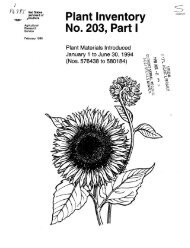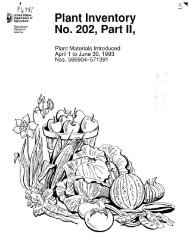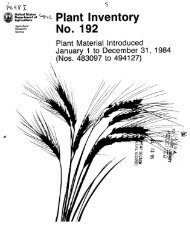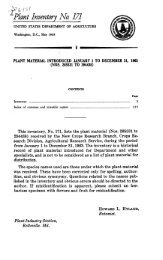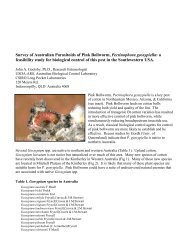Plant Inventory No. 204, Part II - Germplasm Resources Information ...
Plant Inventory No. 204, Part II - Germplasm Resources Information ...
Plant Inventory No. 204, Part II - Germplasm Resources Information ...
You also want an ePaper? Increase the reach of your titles
YUMPU automatically turns print PDFs into web optimized ePapers that Google loves.
States. Received 09/29/1995.<br />
PI 592423. Solanum jamesii Torrey<br />
Wild. BAM 040. Collected 10/05/1995 in Arizona, United States. Coconino<br />
County. Mormon Lake S of Flagstaff. E side of lake among tumbled rocks<br />
on W facing slope. <strong>Plant</strong>s yellowing and apparently only a few flowered<br />
and fruited. Four small mature fruit collected by Dr. Hammond of N<br />
Arizona University who had observed plants there in 1994.<br />
The following were developed by Bernard P. Goplan, Agriculture Canada,<br />
Saskatoon Research Station, 107 Science Crescent, Saskatoon, Saskatchewan S7N<br />
0X2, Canada; J.E.R. Greenshields, Agriculture Canada, Research Branch, Res.<br />
Stn., Saskatoon, Saskatchewan S7N 0X2, Canada. Received 1982.<br />
PI 592424. Lotus corniculatus L.<br />
Cultivar. "CREE"; Saskatoon Compoiste 58; SL-611. CV-34. Pedigree -<br />
Winterhardy introduction (S-3505) from Russia and 11 winterhardy<br />
accessions (S-4201 to S-4211) from Macdonald College, Quebec. <strong>No</strong>t<br />
morphologically distinguishable from Empire and Leo, semi-erect type of<br />
growth and approx. the same height and date of first bloom. Equal to Leo<br />
in winterhardiness, superior to Empire in forage yield and<br />
winterhardiness, seed yield and seedling vigor, and superior to Leo in<br />
seed yield. Yields 13% more hay than Empire and approx. the same as Leo.<br />
Yields 15 and 6% more seed than Empire and Leo, respectively.<br />
The following were developed by R.L. McGraw, Missouri Agr. Exp. Sta., Univ.<br />
of Missouri, Dept. of Agronomy, Columbia, Missouri 65211, United States; Paul<br />
Beuselinck, USDA, ARS, University of Missouri, Department of Agronomy,<br />
Columbia, Missouri 65211, United States. Received 1985.<br />
PI 592425. Lotus corniculatus L.<br />
Breeding. MU-81. GP-61. Pedigree - Three cycles of intercrossing plants<br />
that trace to 56 foreign introductions and 35 experimental synthetics,<br />
or cultivars. Highly heterogenous population developed to provide a<br />
diverse genetic source.<br />
The following were developed by D.A. Miller, University of Illinois,<br />
Department of Agronomy, Turner Hall 1102 S. Goodwin Ave, Urbana, Illinois<br />
61801, United States; Paul Beuselinck, USDA, ARS, University of Missouri,<br />
Department of Agronomy, Columbia, Missouri 65211, United States; L.J. Elling,<br />
USDA, ARS, University of Missouri, Dept. of Agronomy, St. Paul, Minnesota<br />
55108, United States; I.T. Carlson, Iowa Agr. Exp. Sta., Iowa State<br />
University, Dept. of Agronomy, Ames, Iowa, United States. Donated by<br />
University of Minnesota, Department of Agronomy, 1509 Gortner Ave., St. Paul,<br />
Minnesota 55108, United States. Received 1983.<br />
PI 592426. Lotus corniculatus L.<br />
Breeding. NC-83. GP-6. Pedigree - Developed from 30 selected clones from<br />
Illinois (8), Missouri (9), Iowa (6), and Minnesota (7). Yields<br />
significantly more forage than the check Leo. Possesses great<br />
variability for vigor, erectness of growth habit, plant height, stem<br />
length, number of stems/plant, umbels/piant, pods/umbel, seeds/umbel,<br />
seed weight, seed yield, maturity, plant width, disease resistance, and<br />
persistence. Useful for additional selection because of broad genetic<br />
base. Probable area of adaptation northern half of the U.S.<br />
PI 592427. Lotus corniculatus L.<br />
Cultivar. "NORCEN"; NC-83 SYNTHETIC. CV-6. Pedigree - Developed from 9<br />
clones selected from 30 superior clones from 4 breeding programs.<br />
Broadleaved, intermediate growth habit with diverse genetic background.<br />
Resiliency to adapt to different environments within the <strong>No</strong>rth Central<br />
368


